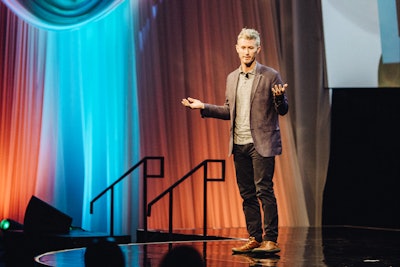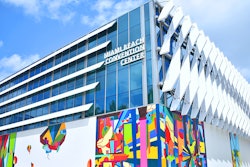
MIAMI/SOUTH FLORIDA—Nearly 1,300 event professionals attended the conference and trade show, which took place May 22 at the Greater Fort Lauderdale/Broward County Convention Center. The event ended with an induction ceremony of top industry leaders to BizBash’s Hall of Fame.
At the Event Innovation Forum, a single-track education session, and Networking Hub on the show floor, industry pros shared strategies for integrating sponsors into a trade show, thinking about attendee engagement, and growing an event business.
Here are some key takeaways.
Engineer attendee engagement from the start.
Thinking about how to engage consumers at an activation is top of mind for Siinc Agency co-founders Sandra Novas and Isabel Chattas, including when they’re trying to win the business. That was the case for an activation for Mastercard at the Miami Open, when they presented the activation through the attendee’s lens. “We approached it through the consumer journey from the beginning to the end, not just the production value,” Chattas said. “Mastercard explained that this approach won us the bid, as we were the only ones that did this. We directed [the experience] from the moment you walk in, through the entrance and hit all the touchpoints that they’d interact with Mastercard. We touched what the benefit would be at each point.”
The approach has worked for public activations for Lacoste, a sales meeting for Tiffany, and events for other high-end clients.
This consumer-first approach is the key to ensuring covetable social media impressions. “The journey dictates the engagement,” Chattas said. “We can’t reach engagement until we know all of the other aspects of the event.”
“A social media moment is an emotional connection. In order to have authentic engagement the connection has to be real," she added. “You can have a beautiful flower wall, but would that make sense for every client? For Audi, or Tiffany?”
Added Novas: “The experience doesn’t necessarily start there or end at the event. Leverage the relationship before and after the event, and ensure that the client honors the activation you put in place.”
Develop sponsorship activations that meet attendee needs.
Diane Vidoni, chief operating officer for eMerge Americas, brought fresh insights from the conference’s 2019 edition, which just wrapped in April with 16,000 attendees and 400 companies including Citibank, P&G, Google, Amazon, and Priceline.com.
At BizBash Live she spoke on how her remapping fit the “Customize, and then amplify” approach to activations, keeping sponsors and attendees equally happy. One example was developing a new sponsor opportunity for Cisco.
“Cisco wanted something new and wanted to speak to the V.I.P.s, so we made them the V.I.P. lounge sponsor and gave them an unplugged stage,” Vidoni said. “We brought in many of the keynotes into the space and they did one-on-ones right then and there.”
To add more value for sponsors—and encourage them to return to future events—Vidoni advised sharing “event metrics that matter,” including social media data, foot traffic totals, comments and suggestions from attendees, as well as detailed, post-show recaps and plans for the future.
Be aware of the cultural context of your event.
Matt Kenny, the newly appointed director of tourism and culture for the City of Miami Beach, emphasized the importance of understanding the current event and cultural climate. “With #MeToo and all these over movements, you have to know the social and moral zone you are playing in,” explained Kenny.
Kenny highlighted how an event he helped produce gained an unpitched or planned appearance by those in the Black Lives Matter movement.
“We could have never paid for that,” explained Kenny. “We were aware of the space we were moving in. If we weren’t, the result could have been very different. If you want to pigeon hole into a specific category, you better know everything about it. It is our responsibility of event producers to ask uncomfortable questions during these brand meetings and make sure we have some cultural responsibility.”
Consider how your event looks on camera.
“You’re no longer designing not just for people who are at the event,” said event producer Raul Rodriguez of 2R Creative, whose clients have included Swatch, Louis Vuitton, and Samsung. “You’re also designing for the outside world.”
He noted that the days of walking media through an event and dictating their photo ops are long gone. “With social media, now everybody is press,” he explained. “Everything needs to look on-camera ready, from every angle.”
When asked how to create a socially shareable experience on a limited budget, he advised: “Focus on one thing and do it well so people know that is the moment to share.”
Scale your business for long-term success.
Chris Weinberg, founder and chief experience officer of Chris Weinberg Events, shared her path to success in planning luxury weddings and social celebrations. Part of her strategy was hiring the right team—and avoiding burnout. “I attended a conference that instructed us to make a list of all the things we do to operate our business, and that about 75 percent of those things can be teachable,” Weinberg said. “I hired one person for the business side and one person on the creative side and trained them. They took on that 75 percent of what I did so I could work on my business instead of in my business.”



















